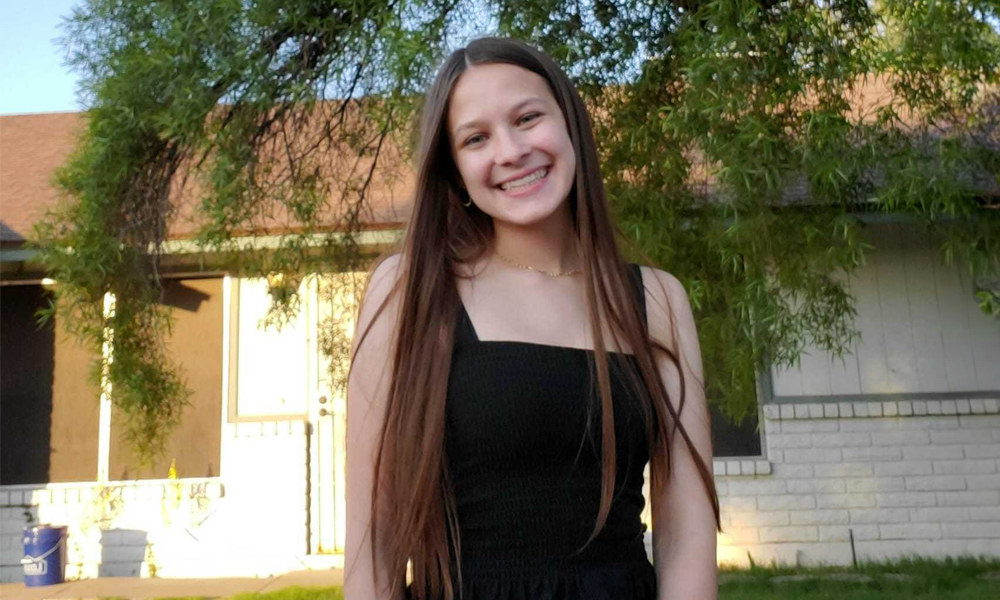A lab-tastic experience

Julissa Brunk is a third-year student at Arizona State University’s Barrett, The Honors College. She is studying biology at The College of Liberal Arts. Born and raised in Mesa, Arizona, she loves to knit socks on long road trips and prioritizes her academics by getting involved with on-campus labs. Throughout her sophomore year, she was in three different labs.
“The Luminosity Lab is a student-driven organization here on campus where we work together to tackle pressing issues in many different fields, such as space, medicine, sustainability and many others,” Brunk said. “My most recent project was a hydroponic system designed to grow bell peppers on the international space station. This means that the plants are grown in water, not dirt.”
Alternatively, in the Vermaas Lab, Brunk primarily focused on cyanobacteria: bacteria that can photosynthesize.
“I participated in this lab under the Barrett College Fellows Undergraduate Research Program,” she said. “The goal of the project I worked on was to create a carbon capture system using the photosynthetic capability of these bacteria to capture carbon dioxide from the air and produce usable biofuels.”
Brunk is most excited to speak about her experience with the Luminosity Lab, which she has participated in since her first semester at ASU.
“For one project, we started with a pretty extensive research phase because the prompt for our project was just plant pods,” Brunk said. “We need to figure out where to go from that because the first step of the process in Luminosity is to find the right problem and know where there's really a gap in technology that we can solve and have the most impact on. We looked into some different problems that NASA has relating to agriculture on the International Space Station (ISS) because there's been a lot of testing done in the field on the ISS, so we had more to base on and designed our project in a way that was more than relying on just an educated guess.”
“Once we determined the location, we wanted to see what kind of problems NASA was having with actually scaling up agriculture on the ISS. We found that they've tested growing many different plants up there, but they haven't actually formed a system meant for production to support astronauts' food intake,” she added.
Designing a system that is efficient in both energy, space and budget was a top priority.
“Although astronauts are getting their nutritional needs met on the ISS, it's extremely expensive and difficult,” she said. “The food is very unappetizing because most of it is freeze-dried and preserved. It's really heavy and expensive to get fresh produce up all the way to the ISS. We settled on making a hydroponic system because they don't require dirt.”
Brunk explained that shipping dirt to the ISS is ineffective because all of the nutrients would be stripped and not reusable. Instead, they use water and a closed circulatory system.
“They can use the water they already have up on the ISS because it’s readily available for use,” Brunk explained. “And, with water, we can control exactly how much nutrients are in there.”
As the nutrients are absorbed by the plants in a hydroponic system, more nutrients can be added.
“After brainstorming, we had a long, long design process,” she said. “We kept trying to find a new solution, but every time we came up with an idea, we realized there would be no gravity, so we had to scrap it. We finally settled on having a system where an aerator would allow the roots to get oxygen every 10 or 20 minutes or so.”
She continued to explain, saying “that a higher-pressure pump would shoot water into the tank, blowing the bubbles off of the roots to make sure the roots can still absorb water. When there's no gravity, air bubbles clump around the roots, blocking them from water instead of just rising to the top.
“After we finished the design process and lots of Computer-Aided Design (CAD) modeling, we finally got to start building,” Brunk explained. “This was so much fun because I personally had hardly any experience with woodworking or metalworking, and I got to learn how to use a lot of different tools to make our model come to life and prove that it actually could work.”
While participating in the labs, Brunk juggled other priorities, such as her weekend job and classes. All of her time commitments were very time-consuming, so she had to find a way to fit all the necessary meetings with her peers within typical business hours.
When asked what advice she would give to students following in her footsteps, she said, “It’s not just the extra time component; it’s also to come up with new ideas and stay focused on multiple projects all at once while you’re still trying to focus on being in school. Keeping track of all these tasks takes a lot of mental energy. Starting in a new lab, especially multiple in one year, require much adjustment.”
“Especially since I’m in biology, our labs have a lot of different specialized equipment,” Brunk explained. “Both times I joined a new lab, finding the specific beaker or chemical I was looking for took forever. It takes a lot of time to get used to, especially the policies of each lab.”
Brunk attributes her ASU lab experience as the starting point for her future career.
“My classes definitely prepared me and gave me a base knowledge, but being in the lab went beyond what I learned in my classes,” she said. “I had to do a lot of research on the specific organisms and the systems I am trying to study to ensure I am working in the right direction.”
Julissa joined the Luminosity Lab through a scholarship. The scholarship to the lab can be found here, along with many more scholarships that can be applied to.